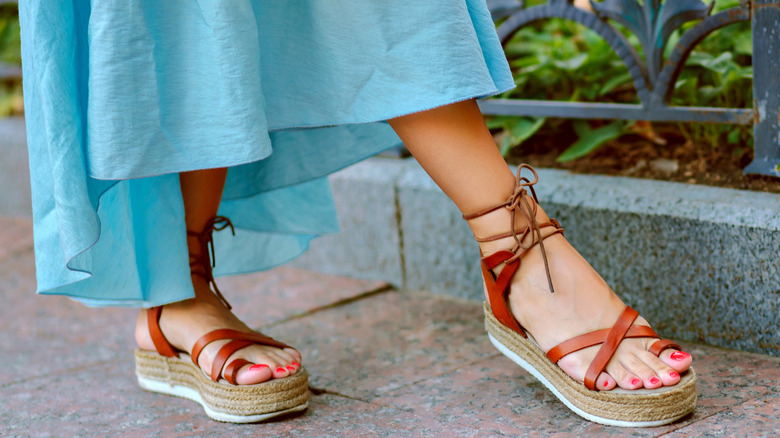The Stylish Women's Shoe Of Ancient Rome That Rivals Modern Fashion
For those who've taken a liking to "gladiator sandals" — those interlaced, strappy sandals that climb the ankle and even calf — your fashion savvy extends further back than you might realize. Ancient Roman gladiators did indeed wear caligae (plural of caliga) — straps of leather hobnailed to a single, rigid sole — as mosaics such as those on Following Hadrian depict, combined with greaves to protect the shins, per Tribunes and Triumphs. But because gladiatorial combat was often historical reenactment cosplay complete with period-accurate garb, they wore lots of other footwear, too.
Regular citizens also donned the kind of footwear now sported by runway models, per the Museum of London: carbatinae, moccasin-like and top-laced; thonged flip-flops; ankle-high calcei boots; and wide, male-power statements that resemble raquettes à neige aka snowshoes. Shoes in ancient Rome (and Greece), were a big deal in general, to the extent where modernity is definitely the spiritual successor to their pedestrian obsession. Shoes and sandals were symbols of status, and only the poorest would go shoeless in public, despite peasant Britons in medieval times going barefoot 1000 years later. The Greek poet Aeschylus, for instance, per Vogue, developed a raised wedge heel to "give added majesty" to his actors, while the highest of the high, Julius Caesar himself, notoriously wore red boots to signify his power, in place of traditional royal purple, as Ancient History Magazine says.
One shoe, in particular, discovered in the ancient Saalburg fort in Germany, perfectly represents exactly how fashion-conscious the Romans were.
A highly decorated symbol of status and power
The Roman fort in Saalburg, Germany — about smack dab in the middle of Frankfurt, Dresden, Leipzig, and Nurnberg — was occupied about 90-260 CE, as All That's Interesting tells us. About 2000 people lived inside its walls, surrounded by an external village. The fort, now a museum and dedicated UNESCO World Heritage Site, has produced lots of valuable archaeological finds. It's got walls, temples, and trees, as the Saalburg website shows, but the shoe in question? It was found in a well.
The shoe — sandal, really — is a gloriously decorated caligae punctured by geometric designs, lacy decorative patterns, and rows of ovals across the collar. Its sole is heavier, which means it was worn outside. Its bevy of embellishments indicates it was not only a lady's shoe, but a wealthy lady. If someone wore these down the street in the ancient Roman empire, they'd turn heads as easily as a pair of shoes from a modern Italian master.
Far from being the only find of its kind, repositories such as the Museum of London contain over 3,500 such leather artifacts, 89% of which are footwear. 22% of them are large and bulky enough to be men's, typically found at military locations, and the rest are women's. Many are highly ornate and trimmed with symbols, designs, astrological signs, gold leaf, and hobnailed patterns, or have copper-alloy studs in the sole that left messages in soft ground, even anti-imperial political protest messages.
Form over function, plus lots of rocking socks with sandals
Lest you think that the Romans ranked style above all else, they were pragmatists first. While the Greeks may have preferred "form over function" from 1000-700 BCE, as Startup Fashion says, the Romans reengineered some practical lessons from their military back into civilian life. Nothing about any shoe's core construction was incidental. As Ancient History Magazine quotes of caligae, the shoe that gave rise to modern gladiator sandals, "The nailing on the undersole is not random: the characteristic D-shaped pattern distributed the support where needed. The pattern identified footprints of soldiers, even on drying clay tiles. This pattern is echoed almost two thousand years later on the bottom of modern sport shoes." Even the mere 2000-year preservation of Roman footwear is due to vegetable tanning technology derived from the need to have a more long-lasting shoe for soldiers, as ThoughtCo describes.
That being said, some Roman fashion choices might not fly these days. As the Museum of London explains, colder, non-Mediterranean climates within the empire required the use of not only shoes, but socks. However, folks were reluctant to give up the often hole-based decorations in their shoes, and as a result, not only wore the modernly reviled sock-and-sandal combo, but used the punching patterns in their sandals to display colorfully dyed socks beneath. Probably not a good idea to make fun of a soldier or gladiator rocking this look, though.


